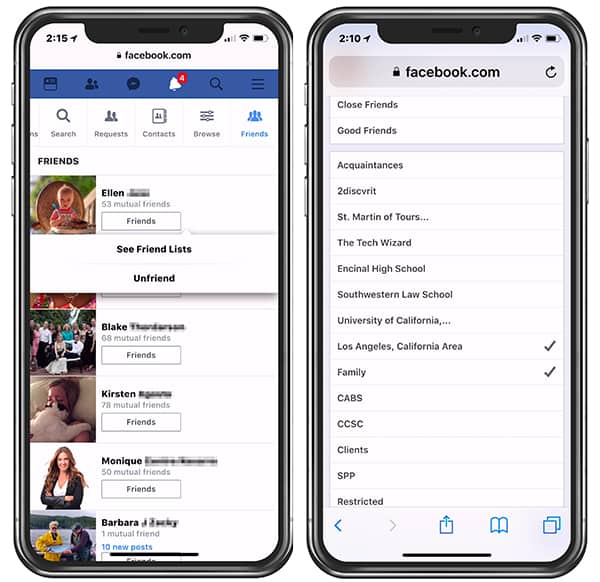
How to Control What Posts You See on Your Facebook Newsfeed
Over the past 10+ years, Facebook has grown to over two billion active monthly users. It provides a great way to stay connected with family and friends, old and new, but it also has a lot of noise that can drive you crazy.
Love it or hate it, Facebook likely isn’t going anywhere soon. Fortunately, you have more control over what you see on your Facebook page than many people realize.
As you may have heard over the past few months, Facebook is updating their algorithms yet again to help make it a “better experience.” So, what does the latest round of changes mean for you?
According to Facebook, they are now giving higher priority to those people who you have identified as family members, or close friends, or posts by people or organizations you interact with the most.
As a result, you should be seeing more of your friends and less news and pages. Even with the changes, your news feed isn’t going to get perfect magically. You must tell Facebook what you care about and want to read on when you open your feed.
How is it done?
Engage with Posts
One of the main ways Facebook is going to decide which of the thousand potential posts to display on your unique News Feed page is by your ‘engagement’ with it.
The News Feed is the default page you see when you open Facebook. It is a collection of recent posts from those you follow, or the business pages you have ‘liked.’
By engagement they mean interaction. Like/love the post. React to it in some way or write a comment. Sharing the content with others, on the news feed or within Messenger, is always an excellent means of engagement.
Social interaction is Facebook’s mission. Activity through comments or like, love, cry reactions are high-ranking factors for their software. If you aren’t reacting, you aren’t connecting, and the algorithms assume you don’t like what you see.
Be Cliquey
While I am sure mom told you that being cliquey isn’t nice, with Facebook you can do it without making anyone feel bad.
Within your group of friends, you can create lists that no one else can see. The people you add to your “Close Friends” list will show up in your notifications when they post something, so you are alerted as soon as they post.
Creating lists, or adding friends to various lists you might have, can only be done in the browser view of Facebook. It isn’t an option in the phone app. To see your friends lists, touch the menu icon (three lines) and go to Friends. Touch the box with “friend” under someone. Choose “See Friends List.”
Also, you can segment your friends into lists such as acquaintances or co-workers, which allows you to select with whom you are sharing specific posts. There is also a Restricted list consisting of people who you are friends with, but you don’t want to see posts, such as your boss.
Be Proactive with Posts

Every post has three dots in the upper right-hand corner. Options vary for friends and companies/organizations you have proactively ‘liked’ or ‘followed’ versus advertisements.
For friends or company pages that you ‘like,’ these are the options:
- Hide that specific post. It comes in handy when there is a post that is getting a lot of comments and keeps coming up on your news feed.
- Temporarily ‘snooze’ that person for 30 days. For those friends who want to share every detail of their month-long cleanse.
- Unfollow them to never see posts. The beauty of the unfollow option is no one knows you unfollowed them so no hurt feelings.
For sponsored posts (ads), Facebook tries to serve up ads that are relevant to you, but they don’t always get it right. If there is an ad in your news feed, you don’t want to see, click on the three dots on the post and hide the ad.
Facebook will understand you don’t want to see this ‘type’ of material. The more you do this, the better the ads will be addressed to your interests. Understand, however, that you cannot get rid of all the ads. Focus on content that is out of your wheelhouse, or is offensive.
Be Picky with Your Preferences
Another way to start creating a news feed full of interesting and relevant content is to update your News Feed Preferences. On your phone, touch the menu icon on the bottom far right, then scroll to Settings and touch News Feed Preferences.
On your laptop/desktop, click the small down arrow in the upper right-hand side of your page and click on News Feed Preferences.
Within these preference settings you have multiple options to customize your feed:
- You can prioritize who you want to see first in your feed.
- If necessary, you can unfollow people. Remember, they will still be your ‘friends,’ and they don’t know you are unfollowing them.
- See who you have unfollowed in the past and reconnect with them if you want to give them another shot.
- Find companies/organizations to follow based on what Facebook thinks you will like.
You can complain until the cows come home how annoying Facebook is, but you have a lot of control over what you see. Through your social interaction, or by taking some time to tell Facebook what you like, you can make your Facebook experience much more enjoyable.
Do you engage with your near and dear, or public pages you have liked, such as Sixty and Me? Are you making comments and seeing the content you want to see? What’s your biggest beef about Facebook? Please share in the comments below.
Tags Technology








